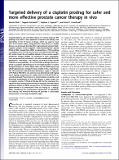Targeted delivery of a cisplatin prodrug for safer and more effective prostate cancer therapy in vivo
Author(s)
Dhar, Shanta; Kolishetti, Nagesh; Lippard, Stephen J.; Farokhzad, Omid C.
DownloadDhar-2011-Feb-Targeted delivery of a cisplatin prodrug for safer and more effective prostate cancer therapy in vivo.pdf (1.234Mb)
PUBLISHER_POLICY
Publisher Policy
Article is made available in accordance with the publisher's policy and may be subject to US copyright law. Please refer to the publisher's site for terms of use.
Terms of use
Metadata
Show full item recordAbstract
Targeted delivery and controlled release of inactive platinum (Pt) prodrugs may offer a new approach to improve the efficacy and tolerability of the Pt family of drugs, which are used to treat 50% of all cancers today. Using prostate cancer (PCa) as a model disease, we previously described the engineering of aptamer (Apt)-targeted poly(D,L-lactic-co-glycolic acid)-b-poly(ethylene glycol) (PLGA-b-PEG) nanoparticles (NPs) encapsulating a Pt(IV) prodrug c,t,c[Pt(NH3)2-(O2CCH2CH2CH2CH2CH3)2Cl2] (1) (Pt-PLGA-b-PEG-Apt-NP), which target the extracellular domain of the prostate specific membrane antigen (PSMA), for enhanced in vitro cytotoxicity. Here we demonstrate enhanced in vivo pharmacokinetics (PK), biodistribution, tolerability, and efficacy of Pt-PLGA-b-PEG-Apt-NP (150±15 nm encapsulating ∼5% wt/wt Pt(IV) prodrug) when compared to cisplatin administered in its conventional form in normal Sprague Dawley rats, Swiss Albino mice, and the PSMA-expressing LNCaP subcutaneous xenograft mouse model of PCa, respectively. The 10-d maximum tolerated dose following a single i.v. injection of Pt-PLGA-b-PEG-NP in rats and mice was determined at 40 mg/kg and 5 mg/kg, respectively. PK studies with Pt-PLGA-b-PEG-NP revealed prolonged Pt persistence in systemic blood circulation and decreased accumulation of Pt in the kidneys, a major target site of cisplatin toxicity. Pt-PLGA-b-PEG-Apt-NPs further displayed the significant dose-sparing characteristics of the drug, with equivalent antitumor efficacy in LNCaP xenografts at 1/3 the dose of cisplatin administered in its conventional form (0.3 mg/kg vs. 1 mg/kg). When considering the simultaneous improvement in tolerability and efficacy, the Pt-PLGA-b-PEG-Apt NP provides a remarkable improvement in the drug therapeutic index.
Date issued
2011-01Department
MIT-Harvard Center for Cancer Nanotechnology Excellence; Massachusetts Institute of Technology. Department of Chemistry; Koch Institute for Integrative Cancer Research at MITJournal
Proceedings of the National Academy of Sciences of the United States of America
Publisher
National Academy of Sciences (U.S.)
Citation
Dhar, S. et al. “Targeted Delivery of a Cisplatin Prodrug for Safer and More Effective Prostate Cancer Therapy in Vivo.” Proceedings of the National Academy of Sciences 108.5 (2011) : 1850-1855. ©2011 by the National Academy of Sciences.
Version: Final published version
ISSN
1091-6490